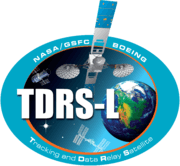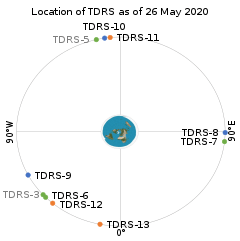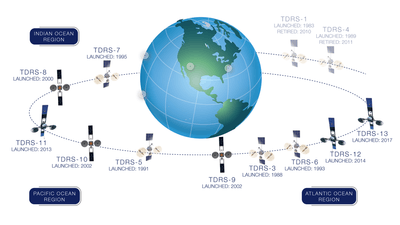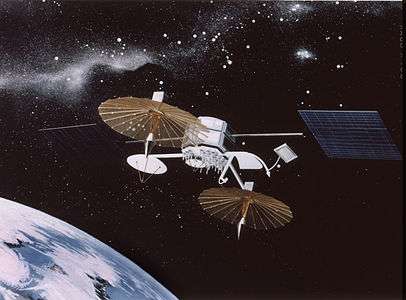TDRS-12
TDRS-12, known before launch as TDRS-L, is an American communications satellite operated by NASA as part of the Tracking and Data Relay Satellite System. The twelfth Tracking and Data Relay Satellite, it is the second third-generation spacecraft to be launched, following TDRS-11 in 2013.[4]
 TDRS-L at the Astrotech payload processing facility | |
| Mission type | Communications |
|---|---|
| Operator | NASA |
| COSPAR ID | 2014-004A |
| SATCAT no. | 39504 |
| Mission duration | Planned: 15 years Elapsed: 6 years, 6 months, 22 days |
| Spacecraft properties | |
| Bus | BSS-601HP |
| Manufacturer | Boeing |
| Launch mass | 3,454 kg (7,615 lb)[1] |
| Start of mission | |
| Launch date | 24 January 2014, 02:33 UTC[2] |
| Rocket | Atlas V 401 |
| Launch site | Cape Canaveral SLC-41 |
| Contractor | United Launch Alliance |
| Orbital parameters | |
| Reference system | Geocentric |
| Regime | Geosynchronous orbit |
| Perigee altitude | 35,785 kilometers (22,236 mi)[3] |
| Apogee altitude | 35,797 kilometers (22,243 mi)[3] |
| Inclination | 6.77 degrees[3] |
| Period | 1436.03 minutes[3] |
| Epoch | 22 January 2015, 07:10:47 UTC[3] |
 | |
Spacecraft
TDRS-12 was constructed by Boeing, based on the BSS-601HP satellite bus. Fully fueled, it has a mass of 3,454 kg (7,615 lb), with a design life of 15 years.[1] It carries two steerable antennas capable of providing S, Ku and Ka band communications for other spacecraft, with an additional array of S-band transponders for lower-rate communications with five further satellites.[4] The satellite is powered by two solar arrays, which produce 2.8 to 3.2 kilowatts of power, while an R-4D-11-300 engine is present to provide propulsion.[1][5]
Launch
The United Launch Alliance was contracted to launch TDRS-12. The spacecraft was launched on 24 January 2014 at 02:33 UTC (21:33 local time on 23 January).[2] An Atlas V rocket was used, flying in the 401 configuration, with tail number AV-043.[5] After launch, TDRS-12 was deployed into a high-perigee geosynchronous transfer orbit.[6] The spacecraft raised itself into a geosynchronous orbit using its onboard propulsion system.
Gallery




 Location of TDRS as of 22 May 2020
Location of TDRS as of 22 May 2020 Location of TDRS as of March 2019
Location of TDRS as of March 2019
References
- Krebs, Gunter. "TDRS K, L, M". Gunter's Space Page. Retrieved 23 January 2013.
- "TRDS-L Lifts Off". NASA. Retrieved 24 January 2014.
- "TDRS-12 Satellite details 2014-004A NORAD 39504". N2YO. 22 January 2015. Retrieved 25 January 2015.
- "TDRS-K Media Kit" (PDF). NASA. Retrieved 23 January 2014.
- Graham, William (23 January 2014). "ULA set to open 2014 campaign with Atlas V launch of TDRS-L". NASASpaceflight.com. Retrieved 23 January 2014.
- "TDRS-L Atlas V Mission Overview" (PDF). United Launch Alliance. Archived from the original (PDF) on 1 February 2014. Retrieved 23 January 2014.
